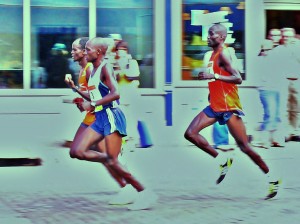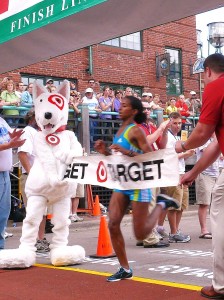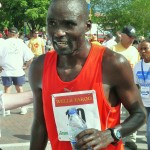Kenyans claim 9 of top 10 at Grandma’s
The question “Which Kenyan will win this year?” was far more than just cynical rhetoric in 2010, at the 34th running of Grandma’s Marathon, which had its familiar upbeat theme tinged with sadness in the aftermath. Kenya’s involvement was only joyful, with Philemon Kemboi leading a contingent that finished 1-5 and had nine of the top 10.
Kemboi’s surprising late bid left Chris Kipyego and David Rutoh behind over the final mile, and his third-to-first burst broke the Canal Park tape at 2 hours, 15 minutes, 44 seconds. It was Kemboi’s first marathon victory ever, although it was Kenya’s 10th in the last 14 Grandma’s Marathons.
The race will, unfortunately, be remembered for having sustained the first fatality in the Marathon’s 34-year history. Norman Ruth, 64, from Duluth’s suburb of Hermantown, finished the 20th Annual Garry Bjorklund Half Marathon, which started earlier in the day, but after finishing he required medical attention, and died of an apparent heart attack. He was attended at the medical tent near the finish line and then hospitalized, but didn’t recover.
While Duluth’s premier sports event is annually well-promoted and attains numerous pages of publicity, organizers were obviously unprepared to deal with the tragedy. Later on race day, only the fact that someone had died in the half-marathon was disclosed.
Meanwhile, out on the course along Lake Superior’s North Shore, the full marathon was being taken over by the three top runners, all making their first visits to Duluth. They led the swift crop of runners who make their annual pilgrimage to Duluth and return home by bolstering their East African nation’s economy.
“It was the biggest race I’ve ever won,” said Kemboi, who earned $10,900. “I will go home…and I will go to the bank. I feel good about being able to help my family’s life to improve.”
Kenya’s elite runners had won nine of 13 before Minnesota native Christopher Raabe won last year. Raabe ran among the leaders this year, too, and finished sixth as the only interruption to Kenya’s top nine places.
Things were much simpler to follow in the women’s segment, where Buzunesh Deba from Ethiopia, simply sped away from the start, and recorded a personal best 2:31:36 time to beat runner-up and fellow-Ethiopian Yeshimebet Bifa by almost four full minutes.
Deba moved from Ethiopia to New York four years ago, and said watching the New York Marathon in 2008 caused her to decide to become a distance runner. After competing in shorter 5K and 10K races, she started in marathons only last fall.
“The first marathon I entered I won,” she said. Her winning time in the California International Marathon was 2:32:17, and after running seventh in the New York Marathon, she sped into 2010 by winning the National Marathon to Fight Breast Cancer in Florida with a time of 2:33:08. So Saturday’s run was her best by almost a minute.
“My plan was to start fast and try to get ahead,” she said, laughing herself at such obvious strategy, except that she made work. She was alone by the 5-mile mark, and nobody else ever got within view of her.
Mary Akor, who had won the last three Grandma’s, finished fourth, behind the top two Ethiopians, and Everlyne Lagat. Akor, 33, has suffered with recent illness that is scheduled for surgery in the near future, and she had to yield to the youthful Deba, who is 22, and Bifa, 21.
The 20th annual Garry Bjorklund Half Marathon was also owned by African runners. Stephen Muange of Kenya won a close men’s segment in 1:04:24, three seconds ahead of Bado Worku, an Ethiopian who was closely followed by countrymen Derese Deniboba Rashaw and Worku Beyl. The women’s category was won by Caroline Rotich, in 1:12:40, nearly two minutes ahead of Alemtsehay Misganaw in a 1-2 Ethiopian finish.
The festive attitude of marathon day was as high-spirited as usual, because nobody had been informed that, hours earlier, Ruth had become the first fatality in the Marathon’s 34-year history. Dr. Ben Nelson, serving his first race as medical director, made the early evening announcement of the fatality, but said he met with race officials and they decided to release no other information.
The fatality was a shocking irony on a race day with temperatures in the mid-60s, about 20 degrees cooler than the year before, which greatly reduced the number of runners affected by the heat and high humidity. Dr. Nelson said in the full and half marathons, 230 runners required some medical attention, but only four from the finish-line tent and three others from out on the course were sent to hospitals for treatment — a significant reduction from recent years.
Withholding news of the tragedy, intentionally or not, left the day to the usual celebration, and the drama for the full marathon built throughout. Race-watchers along the North Shore saw the Kenyans dominate from start to finish, with the three front-running Kenyans pulling away around the 23-mile mark. By the time they glided off London Road and onto Superior Street, the three lead runners were alone. But even then, there was a surprise finish.
Kemboi, 36, whose best previous marathon time of 2:10:58 was good for only a fifth-place finish in France last year, was loping along right behind the tandem of Kipyego, 36, and Rutch, 24, who said they were anticipating which of the two would make the pivotal move for the lead. Kemboi burst past them both as they turned off Superior Street, and his more experienced rivals couldn’t match his finishing speed.
Kemboi is taller than most other Kenyan runners, at 5-foot-8 and 120 pounds, and when he stretched his legs out running down Fifth Avenue West, his winning time of 2:15:44 beat Kipyego by 16 seconds, with Rutoh three more seconds back in third. Kenyans Kipyegon Kirui and Kennedy Kemei were fourth and fifth. Sixth was Raabe, the Minnesota native who was a surprise winner last year. Raabe, who now lives in Washington, D.C., was followed by four more Kenyans, as the prolific elite visitors were the class of the 5,620 entries who finished the full marathon.
Despite the cooler conditions, the full marathon didn’t threaten any records. Kemboi’s winning time was far off the record established by Minnesotan Dick Beardsley in 1982, at 2:09:37 in the fifth year of the event. In fact, Kemboi’s 2:15:44 was a half-minute off last year’s winning pace, when Raabe won at 2:15:13. But the victory was a breakthrough for Kemboi.
A late starter in competitive running, Kemboi had grown up on a family farm near Kapsabet, about seven hours drive from Nairobi. His family never had a car, he said, and when he realized he could help his family by earning money in distance running, he started seriously training in 2004. Calf injuries hindered him for a couple of years, so he had only entered three previous marathons.
Inexperienced or not, he said, “I thought I could win it.” His top rivals were less convinced. Kemboi, speaking only his native Swahili via an interpreter, said he went along with Kipyego and Rutoh, his two countrymen, when they moved away from the pack. “It wasn’t a bad pace,” Kemboi said. “But when they decided to push forward, I was in agreement that we needed to pick up the pace.”
He said he thought he surprised them when he went for the lead as the three turned off Superior Street, down the Fifth Avenue West hill toward the harbor. Kipyego had run against Rutoh before, but didn’t know Kemboi. After the three leaders got away from the field, Kipyego was running alongside Rutoh and said, “I told this guy, ‘Let’s push, let’s push.’ I told him it was time to break away. I was expecting him, if anyone, to be the one to go for the lead.
“I didn’t know who this other guy was. When he went by us, I tried hard to close the gap, but he was very strong for me. I started thinking, ‘Is HE going to win the race?’ ”
He was, indeed.
Kipyego said Grandma’s is unlike other major marathons, which he suspects limit the number of Kenya runners invited. There were 27 at Grandma’s.
“I saw the list, with so many Kenyans, and I thought, ‘This will be fun,’ ” said Kipyego, He said his sister, Sally, became a top NCAA runner at Texas Tech after growing up running to keep up with her big brother. In Kenya, running ability is naturally attained by a different lifestyle from childhood. In the U.S., kids might be driven six blocks to a playground, a fact Kipyego found amusing.
“We had no cars, no buses, and there were no roads,” said Kipyego, who is from the city of Eldoret. “School was five kilometers away, and there was no school bus. We’d run to school in the morning, run home for lunch, then run back to school, and then run home, every day.”
That is a common thread among the Kenyan runners. Kemboi said he, too, ran from the family farm to school, but it was only one kilometer. Hardly proper training for an elite marathon runner. But even if 36 makes him a late-bloomer, his victory can be a springboard to more marathon invitations.
Comments
Tell me what you're thinking...
and oh, if you want a pic to show with your comment, go get a gravatar!





 John Gilbert is a lifetime Minnesotan and career journalist, specializing in cars and sports during and since spending 30 years at the Minneapolis Tribune, now the Star Tribune. More recently, he has continued translating the high-tech world of autos and sharing his passionate insights as a freelance writer/photographer/broadcaster. A member of the prestigious North American Car and Truck of the Year jury since 1993. John can be heard Monday-Friday from 9-11am on 610 KDAL(www.kdal610.com) on the "John Gilbert Show," and writes a column in the Duluth Reader.
John Gilbert is a lifetime Minnesotan and career journalist, specializing in cars and sports during and since spending 30 years at the Minneapolis Tribune, now the Star Tribune. More recently, he has continued translating the high-tech world of autos and sharing his passionate insights as a freelance writer/photographer/broadcaster. A member of the prestigious North American Car and Truck of the Year jury since 1993. John can be heard Monday-Friday from 9-11am on 610 KDAL(www.kdal610.com) on the "John Gilbert Show," and writes a column in the Duluth Reader.